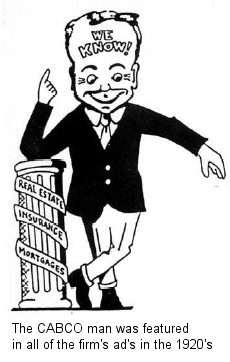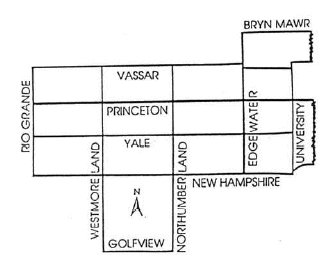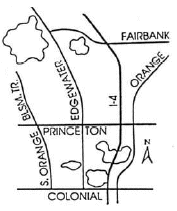History

The street names of

Together the CABCO subdivisions made a rectangle that extended from University to
As the subdivisions grew, so did the idea of College Park as the name for an area that includes many other subdivisions such as Edgewater Heights, Concord Park, Adair Park, Ivanhoe Heights, Anderson Park, Dubsdread, Palm Terrace, Ardsley Manor, Biltmore Shores, and of course, Rosemere.
The College Park Neighborhood Association (CPNA) defines
College Park Timeline
c.1842 The first settlers came to the Orlando area after a truce in the Second Seminole War and passage by Congress of the Armed Occupation Act of 1842, offering land grants to encourage settlement.
c.1849 The troops left Fort Gatlin. D.K. Hall, previously a soldier there, moved north and became probably the first settler near Lake Ivanhoe, and thus probably the first in the section of Orlando we now call College Park.
1854 Also near Lake Ivanhoe, James Speer planted cotton; the Civil War ended this industry
1855 The State of Florida passed an act offering cheap land to settlers.
1856-7 The settlement that had replaced Fort Gatlin became the County Seat, and was given the name Orlando.
c.1857 The William B. Hull family settled in the Lake Fairview area.
1861-5 The Civil War inhibited settlement, despite passage of the Homestead Act in 1862.
1865-6 The first commercial orange grove was planted in the Orlando area.
1875 John Ericsson acquired 80 acres north of what is now the intersection of Princeton St. and Amherst St. to plant citrus; the farmhouse here, 19 West Princeton, dates from the 1880's. Adam Given acquired 40 acres in the vicinity of what is now known as Edgewater Heights, also reportedly to plant citrus.
1876 Marshall Porter acquired 40+ acres in the vicinity of Princeton St. and Lake Ivanhoe; almost half a century later, land from this purchase became a subdivision named College Park.
1880 The Southern Florida Railroad was completed and brought more people to the Orlando area; there were 100 homes in the city limits, plus farmhouses on the outskirts, which included the large neighborhood we now call College Park.
1880+ James Wilcox purchased large amounts of land, much in the neighborhood now known as College Park. He owned land around Lake Concord, and his holdings extended north as far as Florida Hospital. A community, near the intersection of present day Orange Ave. and Princeton St., was named for him.
c.1884 Englishman Algernon Hayden - part of the English migration to the area - bought land around Westmoreland (including Hayden St.) and planted pineapples. 1884 John W. Childress bought a grove near Lake Adair, and reportedly named the lake for his wife.
1885 George Russell purchased substantial holdings on Lake Ivanhoe, including the land on which the Renaissance is located. He established an amusement park there. Orlando's northern city line ran through the middle of Lake Concord, thus reaching into today's College Park neighborhood, then still mostly woods, groves and farms.
1894-5 A big freeze halted, and in some cases reversed, development in the area.
1905 Growth resumed; tourism started to expand.
1911 Orlando's northern city line was extended to Lakeview St.
1914 The Wittenstein family bought land in the northern part of today's College Park for a dairy farm; part of this land was eventually (post-1950) developed as Ardsley Manor.
1915 Daniel W. Clouser of Longwood bought the farm on which the Jack Kerouac bungalow is located. 19teens A few houses from this era remain in the College Park neighborhood, including the house at 1501 Westmoreland.
1919 David Cooper and S.H. Atha purchased George Russell's amusement park and subdivided it as the Ivanhoe Park Replat.
1920 The population within Orlando's city limits was 9,282.
1920-26 Continued growth led to the frantic real estate boom that peaked at mid-decade. The city limits were extended to Par. Subdivision plats were filed for most of the land in what is now considered College Park. Land was subdivided and resubdivided; lots were sold and resold. A sampling of those subdivisions is listed below.
1921 Walter Rose platted Rosemere.
1922 The Ivanhoe Grove Replat and Bentwood subdivisions were filed.
1923 H. Carl Dann and associates started to develop Dubsdread and founded Dubsdread Country Club, which is still on the corner of Par and Edgewater today.
1924 J.P. Holbrook began developing Edgewater Heights. Anderson Park was subdivided by Frank L. Anderson.
1925 Early in the year CABCO (The Cooper-Atha-Barr Company; H.W. Barr had joined the firm) filed the first of the nine subdivisions to which they gave the name "College Park."
1926 A banner year for the expansion of College Park. E.H. Frerking's plat of Ivanhoe Plaza was approved, as were the third and fourth additions to College Park and Silver Lake Park. Reading Road was renamed Shady Lane Drive. The Briscoe Apartment building on Lakeview Avenue at Ivanhoe Boulevard was completed in May, 1926. Plans got underway in June for a new elementary school, Princeton Elementary, which was completed in the same year.
1926-9 Growing tourism brought partial recovery. There was some additional subdivision, and, although a few subdivisions remained partly undeveloped for years, many homes were built.
1927 A license tag for your car was 25¢ and gas was 28¢ a gallon.
1928 The College Park Baptist Church was organized in March of 1928, with Dr. M. Bales as the first pastor. In May, Lake Shore Drive between Bryn Mawr and Hazel was changed to Westmoreland Dr.
1930-4 There was a slowdown in building due to the nationwide depression.
1934-41 Building resumed. Most of the largest College Park homes were built.
1934 Dubsdread Country Club was damaged by fire, but quickly rebuilt.
1935 The city honored the late Dr. Gaston Edwards by rededicating Ivanhoe Park as Gaston Edwards Park, on January 11.
1936 Albert Fink and Morris Morton of Philadelphia remodeled the old Rustic Inn on Lake Ivanhoe, turning it into the Ivanhoe Dinner Club, which opened on Halloween night.
1938 An Ivanhoe Park beautification program began with workers clearing the margin of the lake for landscaping and park purposes. A thirty-foot bridge across the west end of the lake, to connect Poinsettia Avenue and Harrison Street, was approved by the city, with an island to be reserved as a bird sanctuary. Blodgett Gardens opened its doors at 3821 Edgewater Drive, and is still family owned today!
1938- c.1947 Welborn C. Phillips, Sr., bought and built on many of the vacant lots in College Park, particularly those west of Edgewater.
1940 J.H. Hall began a new subdivision, Ivanhoe Heights, bounded by New Hampshire, Yale and Vanderbilt Streets. Dr. Charles Phillips, a Washington D.C. inventor and philanthropist, purchased 220 lots in Dubsdread to build a score of new houses. In that same year, Walter L. Hays, president of the American Building and Loan Association, announced a $600,000 building project for College Park, with 200 homes. The 100-acre site was bounded by Rio Grande, Westmoreland Avenue, Yale Avenue and New Hampshire.
1941-45 There was a slowdown in building due to World War II.
1943 Edgewater Manor went on sale. It was bounded by North Westmoreland Drive, New Hampshire Avenue, Northumberland and Golfview Avenues. The 75-foot lots were selling as low as $300.
1945 Early in September of 1945 the new College Park Baptist Church planned a $100,000 sanctuary, designed by F. Earl DeLoe, to seat approximately 700 people.
1945-55 This decade nearly marked the completion of large-scale single-family development. Most homes built since then are infill single family, or condominium. The decade also saw great expansion in the once small business district along Edgewater Drive.
1946 Beardall Street was changed to Edgewater Court.
1946-1949 The construction period for the first permanent building of the College Park Methodist Church, a pay-as-you-go project.
1948 Residents of College Park petitioned for 23 lots to be set aside for a park. The area was approved, and Dartmouth Park was born. The park is bounded by Dartmouth, New Hampshire, Westmoreland and Edgewater Dr. Also that year, a young man who resided at 815 W. Princeton Avenue won the Guernsey Good Citizenship Award at the Orlando High School. That student was John Young, Orlando's famous astronaut!
1949 Watson Street was changed to Alba Drive. That same year, ground was broken for Lake Silver Shores. The $500,000 development was headed by former U.S. Representative Joe Hendricks. Construction crews worked on the new high school, Edgewater High School, located on a 20-acre tract on Edgewater Drive.
1950 The new Publix Market building on Edgewater Drive was approved, and the Boy Scouts made plans for a new home on city-owned property in the rear of the Princeton Elementary School.
1952 A year of tremendous growth for College Park. The College Park National Bank was announced with a capital of $250,000, located at Edgewater Drive and Vassar St. Edgewater High School officially opened, with keys to the building presented to Principal O.R. Davis. The College Park Branch Post Office was approved. College Park celebrated with an Open House Celebration on October 1 to honor the opening of the new bank and the school. Merchants offered special bargains and a parade was staged. More than 7,000 people visited the bank on opening day, and $660,000 was deposited in accounts! That same year Ardsley Manor, Inc., a corporation composed of Jack and William Demetree, bought 80 acres to develop the residential area in a quarter-million dollar program.
1953 Water Street was changed to Peachtree Road.
1954 Residents of Radclyffe subdivision voted to be annexed to the city. The two-block area covered a 2-block area from Bryn Mawr to Vassar Street.
1955 Contracts were given out for the construction of Robert E. Lee Junior High School on Maury Road.
1957 The College Park National Bank undertook a $100,000 remodeling job, installing four new drive-in windows and anew safety vaults. College Park celebrated the four-laning of Edgewater Drive on March 1, with a festival of bargains and special events, including a parade and barbecue.
1958 Gabriel's Sub Shop opened next to Edgewater High School, and is still family owned and operates at the same location.
1961 On February 17, 1961 the College Park branch of the First Federal Savings & Loan Association was officially opened.
1965 The entire scope of Orlando changed on March 8, 1965 when Governor Haydon Burns dedicated the Interstate-4 strip between Colonial Drive north to Highway 436, on top the Ivanhoe Exchange. Orlandoan John Young and Virgil (Gus) Grissom had their three-orbit flight on March 23.
1969 In April of 1969 the city council passed an ordinance designating the marshy peninsula on Lake Ivanhoe near the intersection of Columbo Circle and Ivanhoe Blvd. as a wild life sanctuary. In May the College Park Art Festival brought in the crowds.
1973 On March 1, 1973, The First National Bank at Orlando changed its name to Sun Bank.
1987 College Park Neighborhood Association formed. It came into being as a neighborhood response to a new road, the Silver Star re-alignment, which threatened to change the quiet residential nature of Princeton and Smith streets. Today we know this road as the continuation of Princeton Street past Orange Blossom Trail.
1992 College Park Neighborhood Association put together this document to answer the question: What is College Park?
2025 College Park celebrates it's 100th Birthday with a community party in Dartmouth Park in Grace Hagedorn's honor that was run by the College Park Historical Society.
Prepared by Grace Hagedorn for the College Park Neighborhood Association Historical Committee, in conjunction with Susan Titour/Community Paper.
